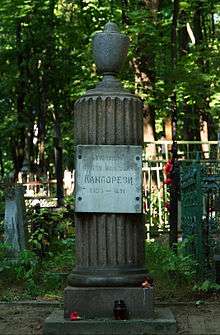Francesco Camporesi
Francesco Camporesi (1747,[1] Bologna – 1831, Moscow) was an Italian architect, painter, engraver and educator who worked in Moscow in 1780s-1820s. Most of his architectural work perished in the Fire of 1812, was severely altered, demolished or otherwise lost.

Biography
Camporesi arrived in Russia in 1780s, probably as an assistant to Giacomo Quarenghi. Extent of his architectural work in 18th century remains disputed, and he is better known as a fine vedutist who documented Moscow prior to the devastating Fire of 1812.
For a decade (1784-1796) Camporesi worked under Quarenghi and Karl Blank on the Catherine's Palace in Moscow, where he was employed both as an architect and a plasterer craftsman. Eventually, he developed into a generalist architect: capable of independently managing construction projects, Camporesi was regularly employed by private clients - for his design talents as well as business capabilities. His input to Nikolai Sheremetev's Ostankino Palace, for example, included interior design, architectural drafts of palace expansion, and also budget schedules and hiring craftsmen.[2]
Works by the architect are best preserved in the vicinity of Yakhroma, in former estates of Apraksin and Sheremetev families. Camporesi also left a significant legacy of unbuilt architectural drafts (preserved at the Moscow Museum of Architecture), including an unusual large octagonal structure codenamed Moscow House. Contemporary studies fail to explain the purpose of this elaborate project; probably, it's octagonal plan was a homage to Saint Michael's Castle, commissioned by one of emperor Paul's statesmen and discarded after Paul's death.[2]
In 1810s-1820s Camporesi was employed by the Commission of Moscow Kremlin; in addition to restoration of Kremlin buildings he coached students of the Kremlin school of architecture, most notably Domenico Giliardi and Afanasy Grigoriev.
Extant architectural works
.jpg) Lobanov-Rostovsky House, 1790s
Lobanov-Rostovsky House, 1790s.jpg) Panorama of Kremlin, 1780s
Panorama of Kremlin, 1780s
Undisputed works:
Attributed with more or less certainty:
- Theater hall of Ostankino Palace
- Church of The Protection of the Mother of God in countess Orlova Andreevskoe estate near Yakhroma, 1803-1821[3]
- Church of Ascension of Jesus in count Apraksin Peremilovo estate, near Yakhroma, 1792-1801
- Lobanov-Rostovsky house at 43, Myasnitskaya Street, Moscow
References
- His tomb, however, states year of birth 1754.
- A. Потькалова. К вопросу о деятельности архитектора Франческо Кампорези (1747 – 1831) в Москве. 1999 Archived 2007-12-18 at the Wayback Machine
- "Dmitrov board of Russian Orthodox church, official site". Archived from the original on February 13, 2012. Retrieved 2008-06-24.
External links
| Wikimedia Commons has media related to Francesco Camporesi. |